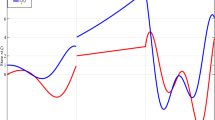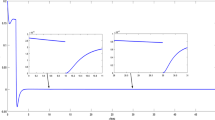Abstract
A frequency domain subspace identification of fractional order systems with input timedelay is studied in this paper. A new identification method, which combines the merits of differential evolution (DE) algorithm and subspace identification algorithm in frequency domain, is presented. For the optimal search of fractional commensurate differential order and time delay parameters, the DE algorithm is applied. For fixed fractional commensurate differential order and time delay, subspace method is performed to obtain the state space model. Simulation results validate the proposed fractional order system identification method.
Similar content being viewed by others
References
T. Pritz, “Five-parameter fractional derivative model for polymeric damping materials,” Journal of Sound and Vibration, vol. 265, no. 5, pp. 935–952, March 2003.
W. C. Chen, “Nonlinear dynamics and chaos in a fractional-order financial system,” Chaos, Solitons and Fractals, vol. 36, no. 5, pp. 1305–1314, June 2008.
A. Carpinteri and F. Mainardi, Fractals and Fractional Calculus in Continuum Mechanics, Springer, Wien, 1997.
R. Malti, S. Victor, and A. Oustaloup, “Advances in system identification using fractional models,” Journal of Computational and Nonlinear Dynamics, ASME, vol. 3, no.2, pp. 021401–021407, April 2008.
T. T. Hartley and C. F. Lorenzo, “Fractional-order system identification based on continuous order distributions,” Signal Processing, vol. 83, no. 11, pp. 2287–2300, April 2003.
Z. B. Wang, G. Y. Cao, and X. J. Zhu, “Identification algorithm for a kind of fractional order system,” Journal of Southeast University (English Edition), vol. 20, no. 3, pp. 297–302, 2004.
R. Malti, S. Victor, A. Oustaloup, and H. Garnier, “An optimal instrumental variable method for continuous time fractional model identification,” Proc. of the 17th IFAC World Congress, pp. 14379–14384, 2008.
M. Thomassin and R. Malti, “Subspace method for continuous-time fractional system idenfication,” Proc. of the 15th IFAC Symposium on System Identification, Sanit Malo, France, 2009.
Y. L. Li and S. L. Yu, “Identification of non-integer order systems in frequency domain,” Acta Automatica Sinica, vol. 33, no. 8, pp. 882–884, September 2007.
D. Valério, M. D. Ortigueira, and J. S. da Costa, “Identifying a transfer function from a frequency response,” Journal of Computational and Nonlinear Dynamics, vol. 3, no. 2, pp. 021207–021213, April 2008.
J. Lin, P. Thierry, and Shoutao Li, et.al, “Identification of noninteger order systems in frequency domain,” Control Theory and Applications, vol. 25, no. 3, pp. 517–520, 2008.
O. Enacheanu, D. Riu, and N. Retière, et al., “Identification of fractional order models for electrical networks,” Proc. of the 32nd Annual Conference on IEEE Industrial Electronics, pp. 5392–5396, November 2006.
J. L. Adams, T. T. Hartley, and C. F. Lorenzo, “Identification of complex order-distributions,” Journal of Vibration and Control, vol. 14, no. 8, pp. 1375–138, September 2008.
R. Pintelon, “Frequency-domain subspace identification using non-parametric noise models,” Automatica, vol. 38, no. 8, pp. 1295–1311, August 2002.
P. Van Overschee and B. De Moor, “Continuoustime frequency domain subspace system identification,” Signal Processing, vol. 52, no. 2, pp. 179–194, July 1996.
D. Bauer, “Order estimation for subspace methods,” Automatica, vol. 37, no. 10, pp. 1561–1573, October 2001.
T. McKelvey, “Subspace methods for frequency domain data,” Proc. of the American Control Conference, Boston, Massachusetts, pp. 673–678, June 2004.
I. Goethals, T. Van Gestel, and J. Suykens, et al., “Identification of positive real models in subspace identification by using regularization,” IEEE Trans. on Automatic Control, vol. 48, no. 10, pp. 1843–1847, October 2003.
R. Storn and K. Price, “Differential evolution — a simple and efficient adaptive scheme for global optimization over continuous space,” Technical Report, International Computer Science Institute, Berkley, pp. 22–25, March 1995.
R. Storn and K. Price, “Differential evolution — a simple and efficient heuristic for global optimization over continuous spaces,” Journal of Global Optimization, vol. 11, no. 4, pp. 341–359, 1997.
R. Mansouri, M. Bettayeb, and T. Djamah, et al., “Vector Fitting fractional system identification using particle swarm optimization,” Applied Mathematics and Computation, vol. 206, no. 2, pp. 510–520, December 2008.
S. Victor, R. Malti, and A. Oustaloup, “Instrumental variable method with optimal fractional differential order for continuous-time system identification,” Proc. of the 15th IFAC Symposium on System Identification, Sanit Malo, France, 2009.
R. Pintelon and J. Schoukens, System Identification: A Frequency Domain Approach, IEEE Press, Piscataway, NJ, USA, 2001.
Author information
Authors and Affiliations
Corresponding author
Additional information
Recommended by Editorial Board member Yoshito Ohta under the direction of Editor Jae Weon Choi.
Wang Li received his Ph.D. degree in Control Science and Engineering from University of Science and Technology of China in 2010. His research interests include fractional order controller design and system identification.
Cheng Peng received his Ph.D. degree in Control Science and Engineering from University of Science and Technology of China in 2007. His research interests include vibration control, system identification and soft computing.
Yong Wang received his Ph.D. degree in Automation from Nanjing University of Aeronautics and Astronautics. His research interests include fractional order systems, active vibration control and system identification.
Rights and permissions
About this article
Cite this article
Wang, L., Cheng, P. & Wang, Y. Frequency domain subspace identification of commensurate fractional order input time delay systems. Int. J. Control Autom. Syst. 9, 310–316 (2011). https://doi.org/10.1007/s12555-011-0213-4
Received:
Revised:
Accepted:
Published:
Issue Date:
DOI: https://doi.org/10.1007/s12555-011-0213-4




